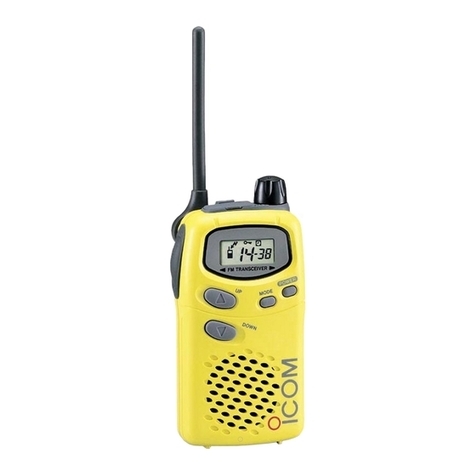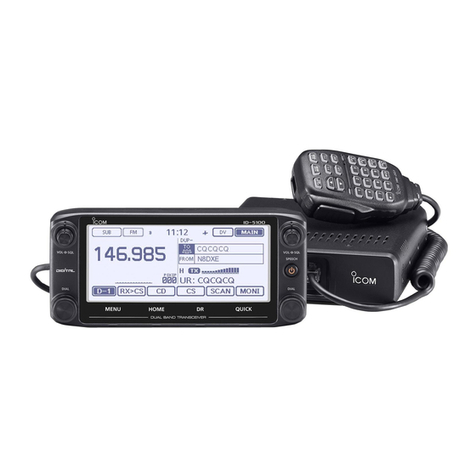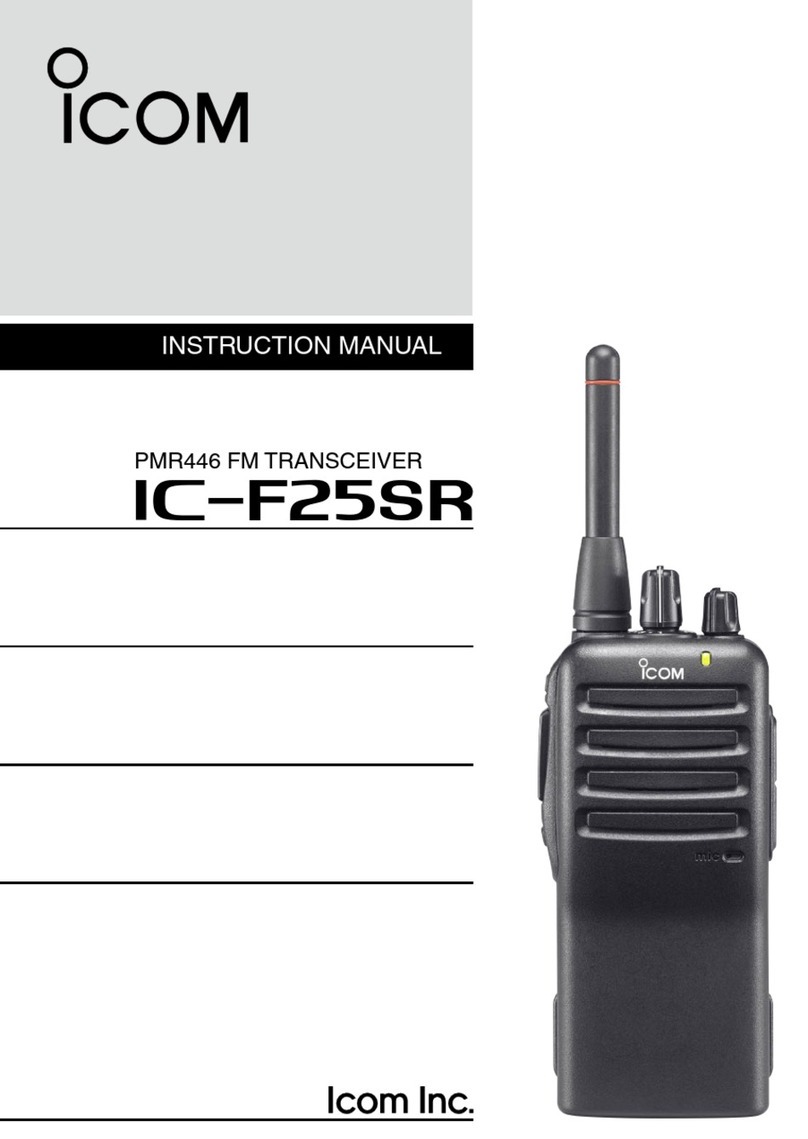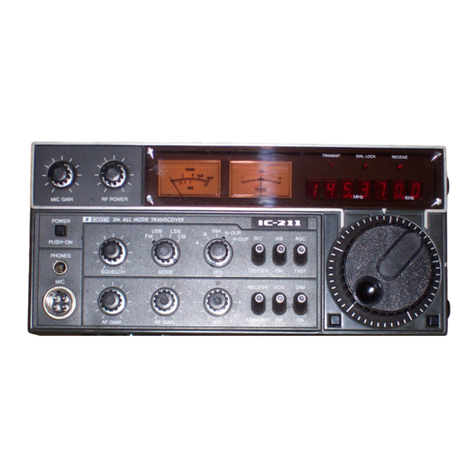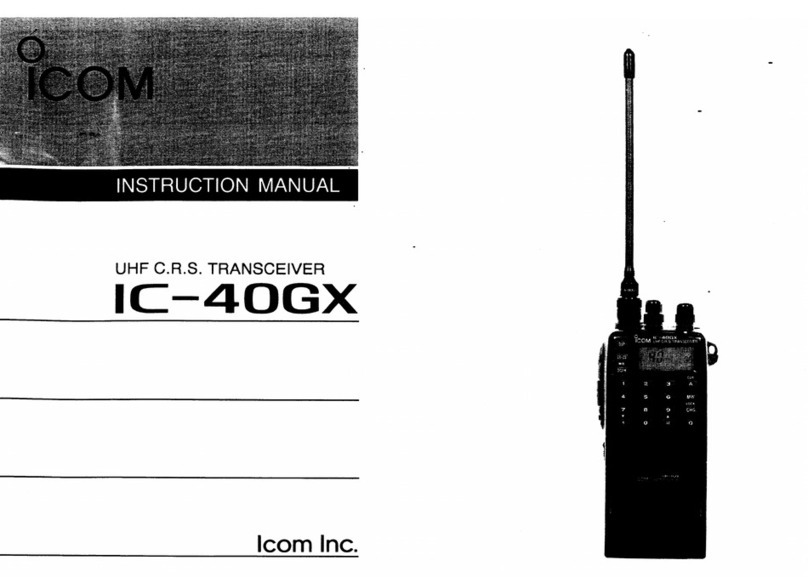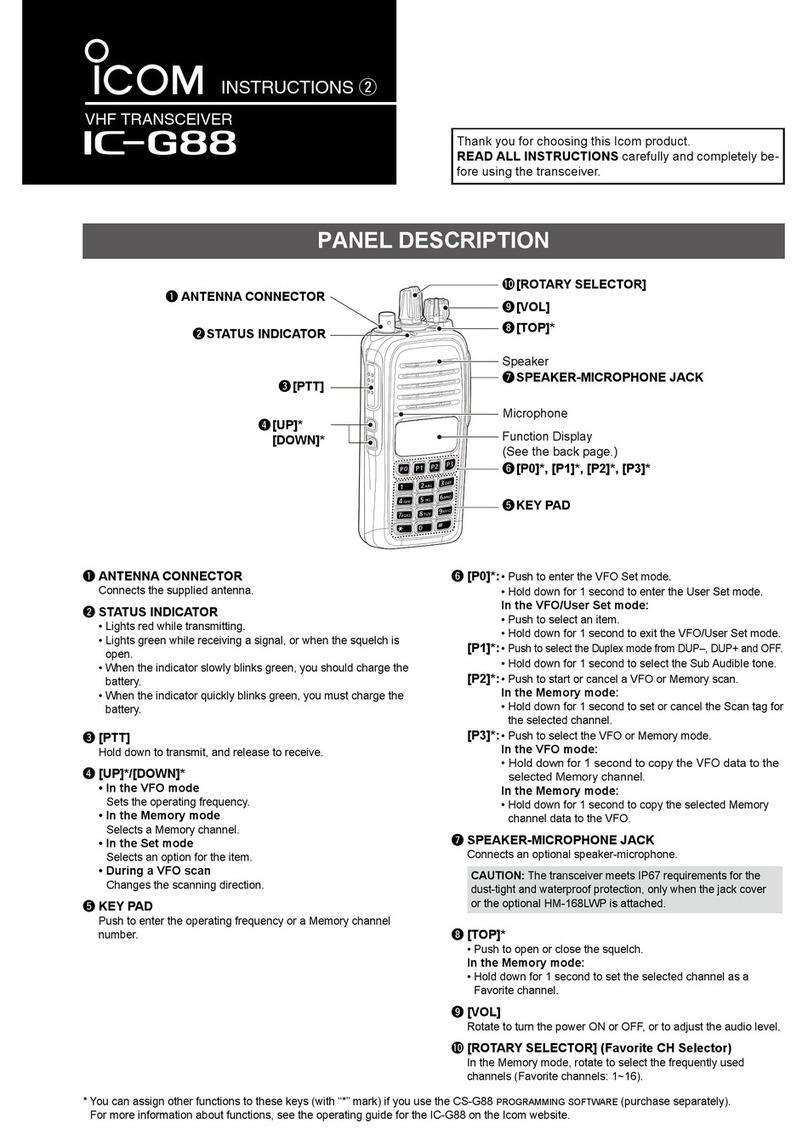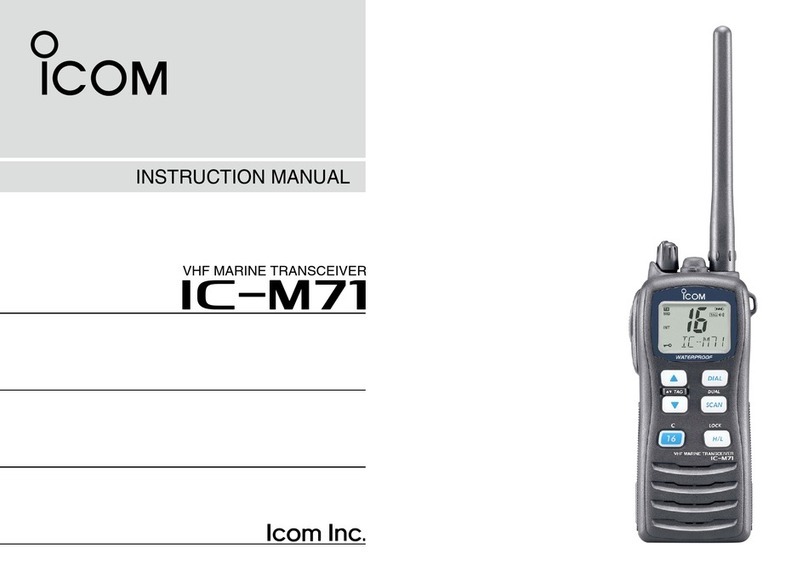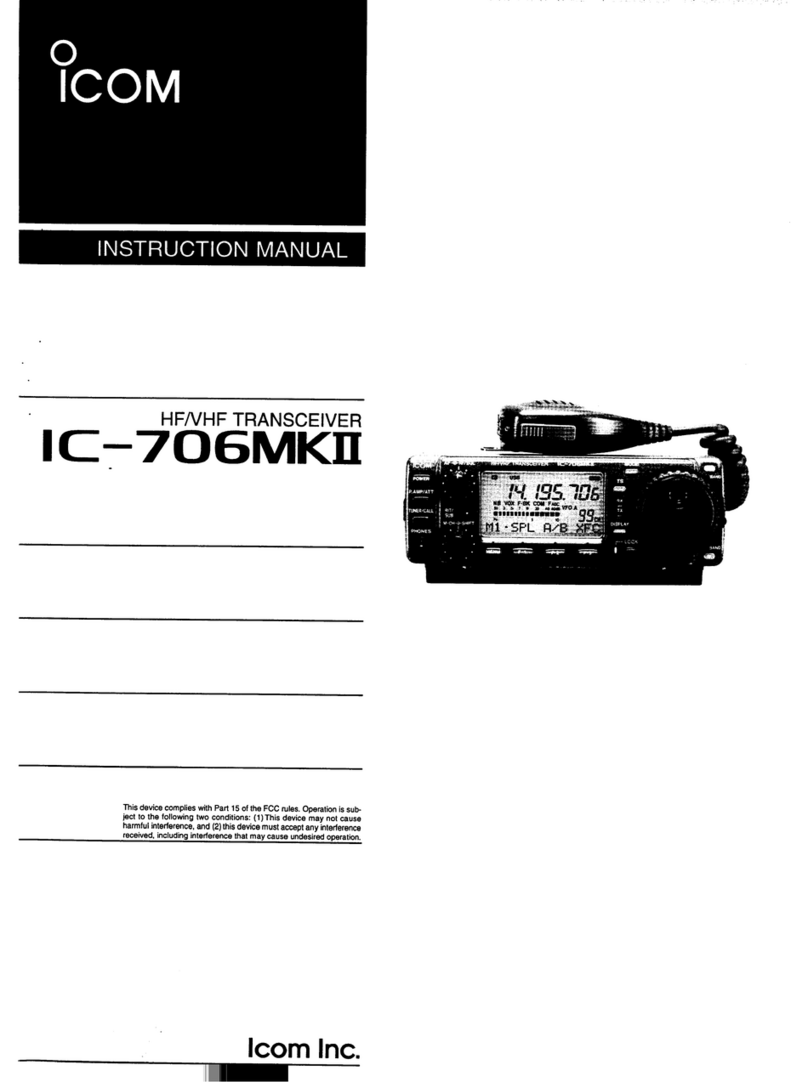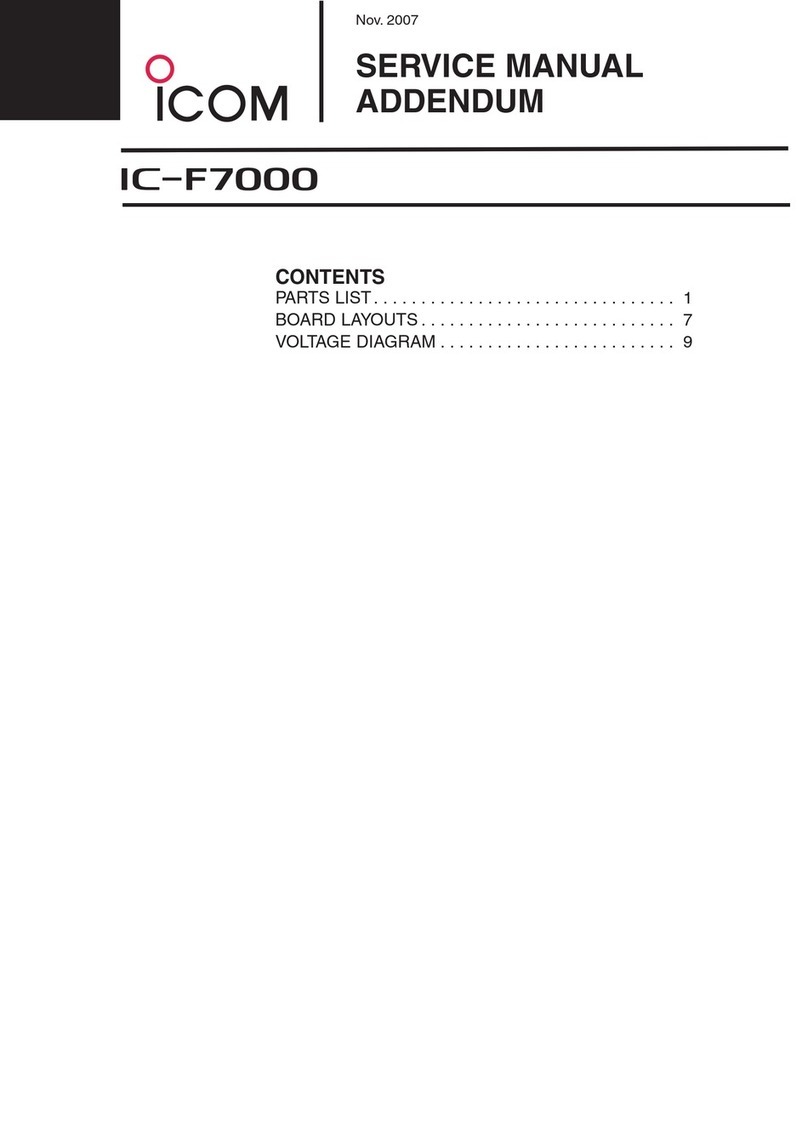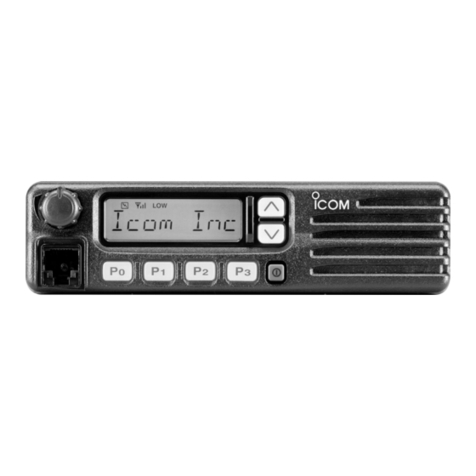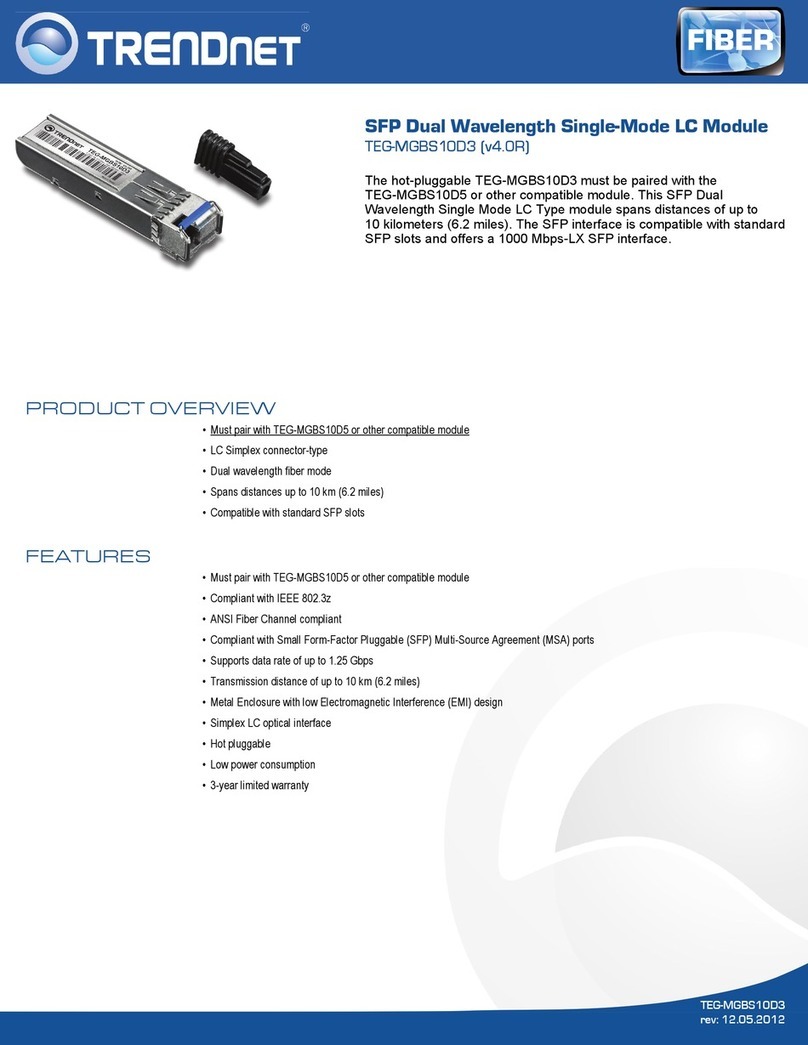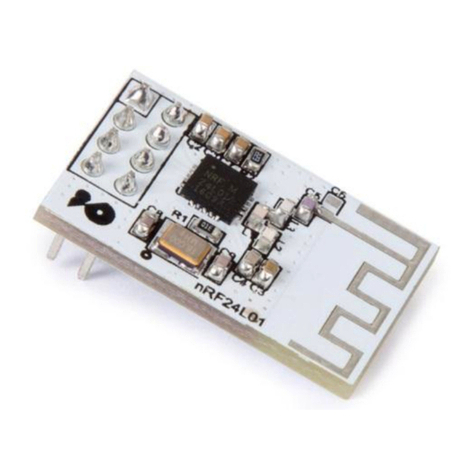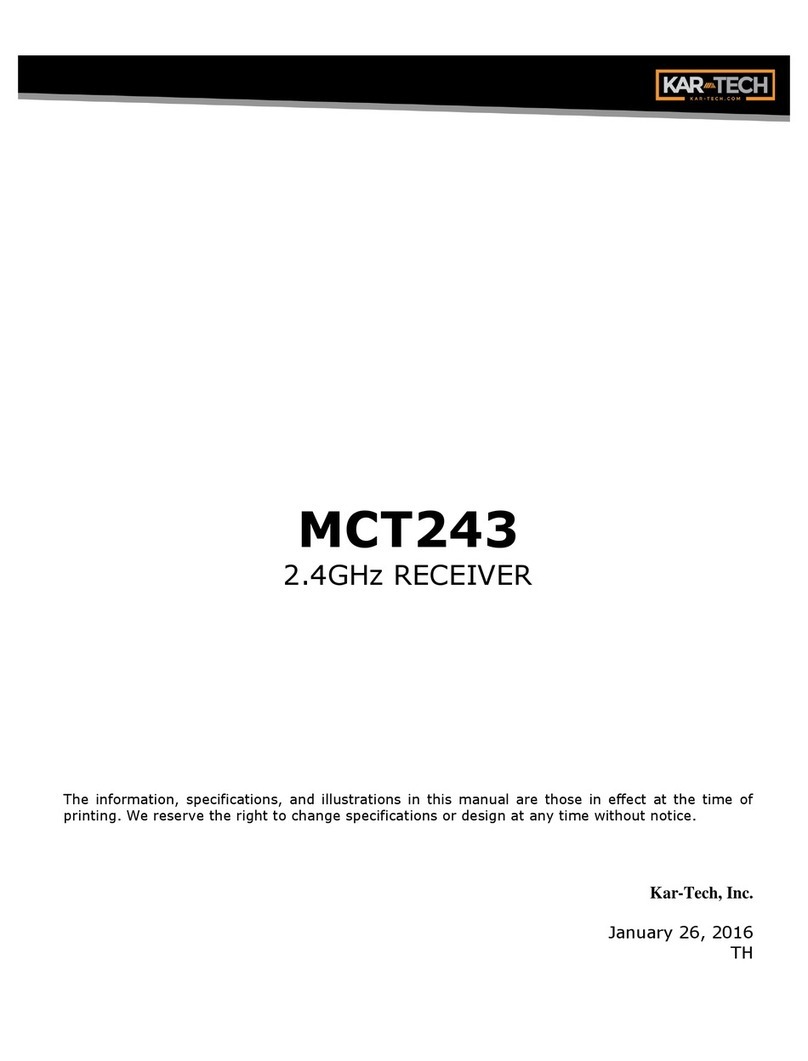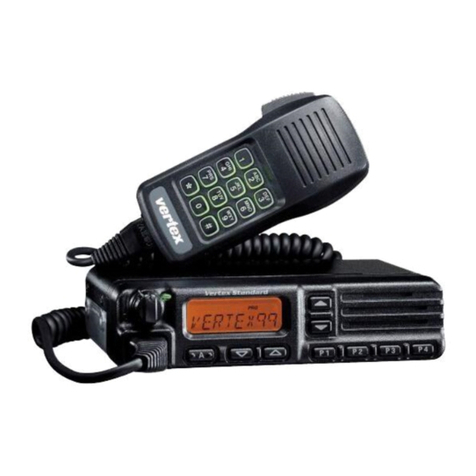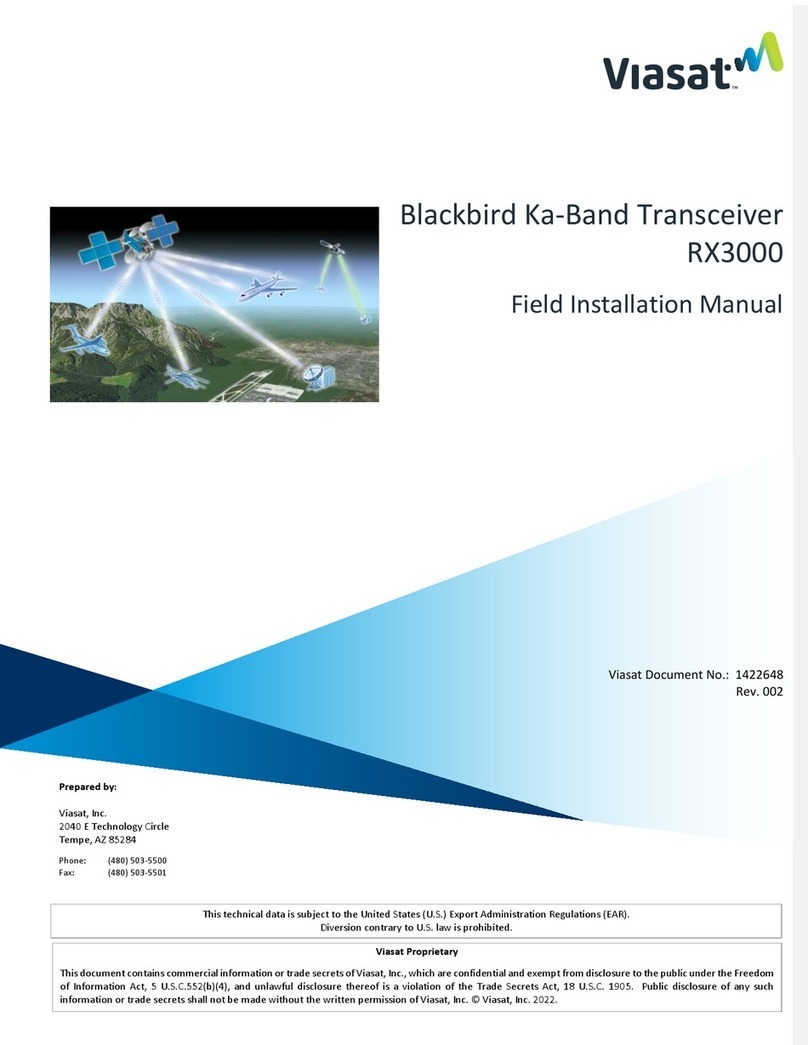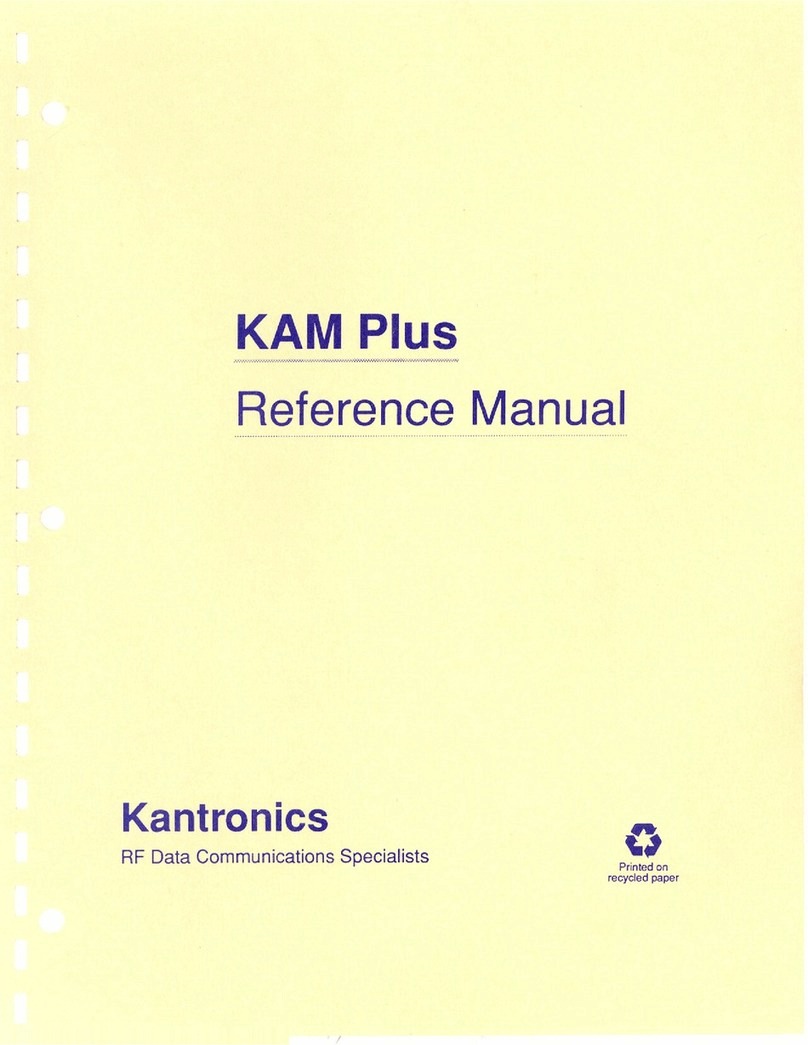Icom IC-Q7A User manual

INSTRUCTION MANUAL
This device complies with Part 15 of the FCC rules.Operation is sub-
ject to the following two conditions: (1) This device may not cause
harmful interference, and (2) this device must accept any interference
received, including interference that may cause undesired operation.
iQ7A
iQ7E
DUAL BAND FM TRANSCEIVER

i
FOREWORD
READ ALL INSTRUCTIONS carefully and completely
before using the transceiver.
SAVE THIS INSTRUCTION MANUAL —This in-
struction manual contains important operating instructions for
the IC-Q7A/E.
EXPLICIT DEFINITIONS
The explicit definitions below apply to this instruction manual.
CAUTIONS
RWARNING! NEVER hold the transceiver so that the
antenna is very close to, or touching exposed parts of the
body, especially the face or eyes, while transmitting. The
transceiver will perform best if the microphone is 5 to 10 cm
away from the lips and the transceiver is vertical.
RWARNING! NEVER operate the transceiver with a
headset or other audio accessories at high volume levels.
Hearing experts advise against continuous high volume op-
eration. If you experience a ringing in your ears, reduce the
volume level or discontinue use.
DO NOT push the PTT when not actually desiring to trans-
mit.
DO NOT operate the transceiver near unshielded electrical
blasting caps or in an explosive atmosphere.
AVOID using or placing the transceiver in direct sunlight or
in areas with temperatures below –10°C (+14°F) or above
+60°C (+140°F).
Place unit in a secure place to avoid inadvertent use by chil-
dren.
WORD
R
WARNING
CAUTION
NOTE
DEFINITION
Personal injury, fire hazard or electric
shock may occur.
If disregarded, inconvenience only. No risk
of personal injury, fire or electric shock.
Equipment damage may occur.
Versions of the IC-Q7E which display “CE”on the serial number
seal, comply with the essential requirements of the 89/336/EEC
directive for Electromagnetic Compatibility.

ii
Even when the transceiver power is OFF, a slight current still
flows in the circuits. Remove batteries from the transceiver
when not using it for a long time.Otherwise, the installed bat-
teries will become exhausted.
For U.S.A. only
CAUTION: Changes or modifications to this device, not ex-
pressly approved by Icom Inc., could void your authority to
operate this device under FCC regulations.
SUPPLIED ACCESSORIES
Accessories included with the transceiver: Qty.
qAntenna (FA-S270C) ...................................................... 1
wHandstrap ....................................................................... 1
eBelt clip ........................................................................... 1
qw e

FOREWORD ...................................... i
EXPLICIT DEFINITIONS ................... i
CAUTIONS ......................................... i
SUPPLIED ACCESSORIES .............. ii
TABLE OF CONTENTS .................... iii
1 ACCESSORY ATTACHMENT ..... 1
2 PANEL DESCRIPTION .......... 2–5
■Panel description ...................... 2
■Function display ........................ 4
3 FREQUENCY AND CHANNEL
SETTING ................................ 6–8
■
VFO and memory/call channels
.. 6
■Operating band selection .......... 6
■Setting a frequency ................... 7
■Setting a tuning step ................. 7
■Selecting a memory channel .... 8
■Lock function ............................ 8
■RIT function .............................. 8
4 BASIC OPERATION ............. 9–11
■Receiving and transmitting ....... 9
■Setting volume level ................ 10
■Setting squelch level ............... 10
■Monitor function ...................... 10
■Receive mode selection ......... 11
■Display backlighting ................ 11
5
MEMORY/CALL CHANNELS
.. 12–14
■General ................................... 12
■
Programming during selection
.. 12
■Programming after selection ... 13
■Transferring memory contents
to another memory ................. 13
■Memory clear .......................... 14
■Call channel ............................ 14
6 SCAN OPERATION ............ 15–19
■Scan types .............................. 15
■Full/band/programmed scan ... 16
■Memory (bank) scan ............... 16
■Selecting scan edges ............. 17
■Skip channel setting ............... 18
■Scan resume condition ........... 18
■Frequency skip function .......... 19
7 PRIORITYWATCH ............. 20–21
■Priority watch types ................ 20
■Priority watch operation .......... 21
8 REPEATER OPERATION .. 22–25
■General ................................... 22
■Subaudible (repeater) tones ... 23
■1750 Hz tone .......................... 24
■Offset frequency ..................... 24
■Auto repeater function ............ 25
9 SUBAUDIBLETONE
OPERATION ....................... 26–27
■Tone squelch operation .......... 26
■Pocket beep operation ............ 27
■Tone scan ............................... 27
10 OTHER FUNCTIONS ......... 28–32
■Set mode ................................ 28
■Dial select step ....................... 29
■Beep tones ............................. 29
■Power saver ............................ 29
■Auto power-off function ........... 30
■Monitor switch function ........... 30
■Dial speed acceleration .......... 31
■Lock function effect ................. 31
■Channel indication mode ........ 32
■Partial reset ............................ 32
■All reset ................................... 32
11 TROUBLESHOOTING .............. 33
12
OPERATION FLOW CHART
... 34–35
13 SPECIFICATIONS .............. 36–37
14 OPTIONS ................................... 38
iii
TABLE OF CONTENTS

1
1
ACCESSORY ATTACHMENT
DAntenna
CAUTION: Transmitting without an
antenna may damage the transceiver.
Insert the supplied antenna into the an-
tenna connector and screw down the an-
tenna as shown at right.
Keep the jack cover attached when jack
is not in use to avoid bad contacts from
dust and moisture.
DBattery installation
qRemove the battery
cover from the trans-
ceiver.
wInstall 2 R6 (AA) size al-
kaline, dry cell or op-
tional Ni-Cd batteries.
•Be sure to observe the cor-
rect polarity.
Keep battery contacts clean. It’s a good idea to clean bat-
tery terminals once a week.
DBelt clip
Conveniently attaches to
your belt.
Slide the belt clip into the
plastic loop on the back of
the transceiver.
DHandstrap
Slide the handstrap through the loop
on the side of the belt clip as illus-
trated at right. Facilitates carrying.

■Panel description
qANTENNA CONNECTOR (p. 1)
Connects the supplied antenna.
wTRANSMIT/RECEIVE INDICATOR [TX/RX] (p. 9)
Lights green while receiving a signal or when the squelch
is open; lights red while transmitting.
ePTT SWITCH [PTT]
➥Push and hold to transmit in 144/400 MHz amateur
bands; release to receive.(p. 9)
➥Push briefly, then push and hold to transmit a 1750 Hz
tone.(Europe and Italy versions only; p.24)
rFUNCTION SWITCH [FUNC]
While pushing this switch, other switches and tuning dial
perform secondary functions.
•“Push [FUNC] + a switch”means “while pushing the [FUNC]
switch, push the switch.”
tBAND SWITCH [BAND]
➥Push to select the operating band (VHF, UHF, etc.). (p.6)
•50 MHz band,*VHF avionics band,* 144 MHz band, 300 MHz
band,* 400 MHz band, 800 MHz band* and 1200 MHz band*
can be selected.
➥Transfers the displayed frequency to the VFO in mem-
ory mode. (p. 6)
➥Push [FUNC] + [BAND] to toggle the RIT function at 800
MHz* and above. (p.8)
➥Push for 2 sec. to set the tuning step for the operating
band or the selected memory channel.(p. 7)
2
2PANEL DESCRIPTION
q
w
e
r
t
y
u
i
o
!0
Function display
(p. 4)
SPEAKER/MICROPHONE
!1
!2

3
2
PANEL DESCRIPTION
yVOLUME CONTROL SWITCHES [VOLY]/[VOLZ]
➥Push to adjust the audio level.(p. 10)
➥Push [FUNC] + either switch to start a scan. (p.16)
➥Push [FUNC] + either switch for 2 sec. to start a tone
scan. (p. 27)
uVFO/MEMORY SWITCH [V/M]
➥Toggles between VFO and memory modes.(p. 6)
➥Enters set mode when pushed for 2 sec. (p.28)
➥Push [FUNC] + [V/M] to enter memory write mode. (p.
12)
➥Push [FUNC] + [V/M] for 2 sec.to write the operating fre-
quency into the selected memory channel in VFO mode.
(p. 13)
➥Push [FUNC] + [V/M] for 2 sec.to write the displayed fre-
quency into the VFO in memory mode. (p.13)
iPOWER SWITCH [POWER]
Push for 2 sec. to toggle the transceiver power ON and
OFF.
oMONITOR SWITCH [SQL] (p. 10)
➥Push and hold to temporarily open the squelch and
monitor the operating frequency.(default behaviour)
➥While pushing, rotate the tuning dial to set the squelch
threshold level.
➥Push [FUNC] + [SQL] to exchange the receive/transmit
frequency and duplex direction when the duplex function
is in use.
!0 CALL/LOCK SWITCH [CALL(LOCK)]
➥Selects the call channel. (p.14)
➥Push [FUNC] + [CALL] to toggle the lock function ON
and OFF. (p. 8)
➥While in the memory channel programming condition,
push [FUNC] + [CALL] for 2 sec. to clear the contents.
(p. 14)
➥Generates a 1750 Hz tone for repeater access while
transmitting.(Europe and Italy versions only;p. 24)
!1 EXTERNAL SPEAKER AND MICROPHONE JACK
[SP/MIC]
Connects an optional speaker-microphone or headset via
an optional OPC-782 PLUG ADAPTER CABLE, if desired.
The internal microphone and speaker will not function
when the OPC-782 is connected. (See p. 38 for a list of
available options.)
!2 TUNING DIAL [DIAL]
➥Rotate [DIAL] to set operating frequencies, memory
channels, set mode contents, etc. (p.7)
➥While pushing [SQL], sets the squelch level.(p. 10)
➥While pushing [FUNC], sets the operating frequency in
100 kHz, 1 MHz or 10 MHz steps in VFO mode.(pgs.7,
29)
➥While pushing [FUNC], sets the operating channel in 10
channel steps in memory mode.(pgs.7, 8)

4
2PANEL DESCRIPTION
■Function display
qRECEIVE MODE INDICATORS (p. 11)
Show the receive mode.
•AM, FM and WFM are available.
wDUPLEX INDICATORS (p. 22)
Appear when semi-duplex operation (repeater operation)
is in use.
•“–DUP”appears when minus duplex is selected;“DUP”only, ap-
pears when plus duplex is selected.
eTONE INDICATORS (pgs. 23, 26, 27)
➥“T”appears when the subaudible tone encoder is in use;
“TSQLë”appears during pocket beep operation and
“T SQL”appears when the tone squelch function is acti-
vated.
➥Only “ë”appears when the pocket beep function is in
use.
rRIT INDICATOR
Appears when the RIT (Receive Incremental Tuning) func-
tion for 800 MHz and above is in use. (p.8)
tFREQUENCY READOUT
Shows the operating frequency, set mode contents, etc.
•The smaller “75,”“50”and “25”to the right of readout indicate 7.5,
5.0 and 2.5 kHz, respectively.
•The decimal point of the frequency flashes during scan.
yMEMORY CHANNEL READOUT
Shows the memory or call channel number, etc.
uMEMORY BANK INDICATOR
Flashes when the bank memory scan is activated.
iMEMORY MODE INDICATOR
Appears when a memory channel is selected.
AM FM DUP TSQLW
75
50
25
PRIOPSKIP
1
BUSY
RIT
MR
9
5
qwe
ui
r
y
t
!0!1!2
!3
!4
o

5
2
PANEL DESCRIPTION
oSKIP SCAN INDICATOR (p. 18)
➥“SKIP”appears when a selected memory channel is set
as a skip channel.
➥“PSKIP”appears when the memory channel frequency
is set as a skip frequency during scanning.
!0 SIGNAL INDICATORS
Shows the relative signal strength while receiving.
!1 PRIORITYWATCH INDICATOR (p. 20)
Appears when priority watch is in use.
!2 BUSY INDICATOR
“BUSY”appears when receiving a signal or when the
squelch is open.
!3 BATTERY INDICATORS
➥Both segments appear when the batteries have enough
capacity.
➥Only the right segment appears when the batteries are
nearing exhaustion.
➥Flash when battery replacement is necessary.
!4 LOCK INDICATOR (p. 8)
Indicates that the lock function is in use.

6
3FREQUENCY AND CHANNEL SETTING
■
VFO and memory/call channels
This transceiver has 2 normal operating modes: VFO mode
and memory (call) mode.
VFO mode is used for setting a desired frequency within the
band range.
➥Push [V/M] once or twice to select
VFO mode.
Memory (call) mode is used for operation of memory (call)
channels which have programmed frequencies.
➥Push [V/M] once or twice to select
memory mode.
•To program a memory, refer to p. 12.
➥Push [CALL(LOCK)] to select a call
channel.
What is VFO?
VFO is an abbreviation of Variable Frequency Oscillator. Fre-
quencies for transmitting and receiving are generated and
controlled by theVFO.
■Operating band selection
The transceiver can receive the 50 MHz band, VHF avionics
band, 144 MHz band, 300 MHz band, 400 MHz band, 800
MHz band* or 1200 MHz band.
➥Push [BAND] several
times to select the de-
sired band.
•When a memory or call
channel is selected, the
first push of [BAND] se-
lects VFO mode (and
transfers the memory or
call channel contents).
When pushing [PTT],
“OFF”appears indicating
the frequency is outside
the 144/400 MHz ama-
teur bands.
*Some frequencies can-
not be received with
the U.S.A. version.
FM
FM
MR
FM
MR
“”appears.
“C1”or “C2”appears.
FM
FM
FM
FM
AM
FM
FM
30–89.995 MHz
90–141.995 MHz
142–254.995 MHz
255–382.995 MHz
383–769.745 MHz
769.750–939.995 MHz
940–1309.995 MHz
BAND
BAND
BAND
BAND
BAND
BAND

■Setting a frequency
qSelect VFO mode with [V/M].
wSelect the desired band with [BAND].
eRotate [DIAL] to change the frequency.
•The frequency changes according to the preset tuning steps.See
the right section for selecting the tuning step.
•Rotate [DIAL] while pushing [FUNC] to change the frequency in 1
MHz steps (default;p.29).
The 1 MHz tuning step (dial select step) can be set to 100
kHz, 1 MHz or 10 MHz tuning steps in set mode.See p. 29
for details.
■Setting a tuning step
Tuning steps can be selected for each band.This transceiver
has 10 tuning steps as follows:
•5 kHz •6.25 kHz •10 kHz •12.5 kHz •15 kHz
•20 kHz •25 kHz •30 kHz •50 kHz •100 kHz
DUsing the band switch
qSelect VFO mode with [V/M].
wSelect the desired band with [BAND].
ePush [BAND] for 2 sec. to enter tuning step setting condi-
tion.
rRotate [DIAL] to select the desired
tuning step.
tPush [BAND] to return to normal
operation.
DUsing set mode
qSelect VFO mode with [V/M].
wSelect the desired band with [BAND].
ePush [V/M] for 2 sec. to enter set mode.
rRotate [DIAL] until “STEP”appears.
•“STEP”disappears after 1 sec. and the previously selected tun-
ing step and “tS”appear.
tWhile pushing [FUNC], rotate [DIAL] to select the desired
tuning step.
yPush [V/M] to exit set mode. 7
3
FREQUENCY AND CHANNEL SETTING
15 kHz tuning step
FM
75
50
25
75
50
25
FM
75
50
25
75
50
25
[DIAL] changes the frequency according
to the selected tuning step.
While pushing [FUNC], [DIAL] changes
the frequency in 1 MHz steps (default).

8
3FREQUENCY AND CHANNEL SETTING
■Selecting a memory channel
qPush [V/M] once or twice to se-
lect memory mode.
•“X”appears when a memory
channel is selected.
wRotate [DIAL] to change the indi-
cated memory channel.
•Only programmed memory chan-
nels can be selected.
•Rotating [DIAL] while pushing
[FUNC] to change the channel in 10
channel steps.
■Lock function
The lock function prevents accidental frequency changes and
accidental function access.
➥Push [FUNC] + [(CALL)LOCK] to toggle the lock function ON
and OFF.
•[POWER], [VOL], [SQL] and [PTT]
can still be accessed while the lock
function is ON (default).
•Accessible switches can be set to 1
of 4 groups in expanded set mode.
See p. 31 for details.
■RIT function
To compensate for the off frequency of a transmitting station,
the transceiver has receive incremental tuning for receiving
frequencies above 835 MHz.
The receive incremental tuning (RIT) shifts only the receive
frequency within approx. ±5 kHz at 850 MHz and ±7 kHz at
1300 MHz.
qSet an operating frequency above 835 MHz.
wPush [FUNC] + [BAND] to turn the RIT function ON.
•“RIT”appears.
eWhile pushing [FUNC], rotate [DIAL] to adjust the shift fre-
quency.
•–5 to 5 appear at the memory chan-
nel readout while setting the shift
frequency.
rTo cancel the function, push
[FUNC] + [BAND] to turn the RIT
function ON.
•“RIT”disappears.
While the RIT function is in use, the dial select step cannot
be used. (pgs. 7, 29)
FM
1
MR
SKIP
FM
MR
[DIAL] changes the
memory channel.
While pushing [FUNC],
[DIAL] changes the
memory channel in 10
channel steps.
FM RIT
FM RIT
BUSY
5
BUSY
9
5
Plus shift
Minus shift
FM
“”appears when the
lock function is in use.

9
4
BASIC OPERATION
■Receiving and transmitting
CAUTION: Transmitting without an antenna may
damage the transceiver.
Make sure alkaline or dry cell batteries are installed. (p. 1)
qPush [POWER] for 2 sec.to turn power ON.
wPush [VOLY] or [VOLZ] to set the desired audio level.
•The frequency display shows the volume level while setting.See
the next page for details.
eSet an operating frequency.(pgs.6, 7)
rSet the squelch level.
•While pushing [SQL], rotate [DIAL].
•The first click of [DIAL] indicates the current squelch level.
•“LEVEL1”is loose squelch and “LEVEL9”is tight squelch.
•“AUTO”indicates automatic level adjustment with a noise pulse
count system.
tWhen a signal is received:
➥The TX/RX indicator lights green.
➥Squelch opens and audio is emitted from the speaker.
➥The S/RF indicator shows the relative signal strength.
yPush and hold [PTT] to transmit, then speak into the mi-
crophone.
•TX/RX indicator lights red.
uRelease [PTT] to receive.
IMPORTANT: To maximize the readability of your transmit-
ted signal, pause a few sec. after pushing [PTT], hold the
microphone 10 to 15 cm from your mouth and speak at a
normal voice level.
qPower switch
ySpeak into
microphone
yPush to transmit
uRelease to
receive
wSet volume
eSelect band
wPush to monitor
rPush for setting
the squelch
eSet frequency
rSet the squelch
level

10
4BASIC OPERATION
■Setting volume level
The audio level can be adjusted through 32 levels.
➥Push [VOLY] or [VOLZ] to set the desired audio level.
•Beep tone sounds while setting. This indicates the approximate
sound level.
•Pushing and holding these keys change the audio level continu-
ously.
•The frequency display shows the volume level while setting.
■Setting squelch level
The squelch circuit mutes the received audio signal depend-
ing on the signal strength.The transceiver has 9 squelch lev-
els, a continuously open setting and an automatic squelch
setting.
➥While pushing [SQL], rotate the
[DIAL] to select the squelch level.
•The first click of [DIAL] indicates the
current squelch level.
•“LEVEL1”is loose squelch and
“LEVEL9”is tight squelch.
•“AUTO”indicates automatic level ad-
justment with a noise pulse count
system.
■Monitor function
This function is used to listen to weak signals or to open the
tone squelch manually.
➥Push and hold [SQL] to monitor the operating frequency.
The [SQL] switch can be set as a monitor ON/OFF switch
in expanded set mode.(p. 30)
AUDIO LEVEL
INDICATION
Min. setting (no audio)
:
Initial setting
:
:
:
Max. setting
Automatic squelch
Maximum level

11
4
BASIC OPERATION
■Receive mode selection
Receive modes are determined by the physical properties of
the radio signals.The transceiver has 3 receive modes: FM,
AM and WFM modes.The mode selection is stored indepen-
dently in each band and memory channels.
Typically, AM mode is used for the air band (118–135.995
MHz) and WFM is used for FM broadcast stations (76–107.9
MHz).
When pushing [PTT], a beep tone sounds indicating the
mode is not FM mode.The transceiver cannot transmit in
AM or WFM mode.
DSetting the receive mode
qPush [V/M] for 2 sec. to enter set
mode.
wRotate [DIAL] until “MOD”ap-
pears.
•“MOD”disappears after 1 sec. and
the previously selected receive mode
and “md”appear.
eWhile pushing [FUNC], rotate
[DIAL] to select the desired re-
ceive mode.
rPush [V/M] to exit set mode.
■Display backlighting
The transceiver has display backlighting with a 5 sec. timer
for nighttime operation. The display backlighting can be
turned ON continuously or turned OFF, if desired.
➥Push any switch except [PTT] and [FUNC];or, rotate [DIAL]
to turn the backlighting ON.
•When auto backlighting is set, the backlighting will automatically
turn OFF when switches and [DIAL] have not been operated for 5
sec.
DSetting the backlighting setting
qPush [V/M] for 2 sec. to enter set
mode.
wRotate [DIAL] until “LIGHT”ap-
pears.
•“LIGHT”disappears after 1 sec. and
the previously selected backlighting
timer and “LI”appear.
eWhile pushing [FUNC], rotate
[DIAL] to select the desired back-
lighting setting.
rPush [V/M] to exit set mode.
Automatic backlighting
Backlighting set mode
Continuously OFF
AM mode
Receive mode set mode
FM mode

12
5MEMORY/CALL CHANNELS
■General
The transceiver has 200 memory channels in 2 banks and 2
call channels for storage of often-used frequencies.
DMemory/call channel contents
The following information can be programmed into memory
or call channels:
•Operating frequency (p. 7)
•Receive mode (p. 11)
•Tuning step (p.7)
•Duplex direction (DUP or –DUP) with an offset frequency
(pgs. 22, 24)
•Subaudible tone encoder or tone squelch ON/OFF (pgs.
23, 26)
•Subaudible tone and tone squelch frequencies (pgs. 23,
26)
•Scan skip setting (p. 18)
■
Programming during selection
qSelect VFO mode with [V/M].
wSet the desired frequency:
➥Select the desired band with [BAND].
➥Set the frequency using [DIAL].
➥Set other data (e.g. offset frequency, duplex direction,
subaudible tone frequency, etc.), if required.
ePush [FUNC] + [V/M] momentarily to indicate memory
channels.
•Do not hold [FUNC] + [V/M] for more than 0.5 sec., otherwise the
memory channel will overwrite the selected memory channel.
rRotate [DIAL] to select the desired channel.
•Call channels (C1, C2) and VFO (VF), as well as regular memory
channels, can be programmed in this way.
•Rotate [DIAL] while pushing [FUNC] to select a memory channel
in 10 channel steps.
tPush [FUNC] + [V/M] for 2 sec. to program.
FM DUPTSQL
MR
FM DUPTSQLFM
MR
momentarily
blank channel
for 2 sec.
+
V/M
FUNC
+
V/M
FUNC
[EXAMPLE]: Programming ch 40 during selection.

13
5
MEMORY/CALL CHANNELS
■Programming after selection
qSelect memory mode with [V/M].
wSet the memory channel to be programmed with [DIAL].
•Rotate [DIAL] while pushing [FUNC] to select a memory channel
in 10 channel steps.
ePush [V/M] to select VFO mode.
rSet the desired frequency:
➥Select the desired band with [BAND].
➥Set the frequency using [DIAL].
➥Set other data (e.g. offset frequency, duplex direction,
subaudible tone frequency, etc.), if required.
tPush [FUNC] + [V/M] for 2 sec. to program into the se-
lected channel.
■Transferring memory
contents to another memory
qSelect memory mode with [V/M].
wSet the desired memory channel with [DIAL].
•Rotate [DIAL] while pushing [FUNC] to select a memory channel
in 10 channel steps.
•Call channel contents can be transferred in the same manner.
Select a call channel in this case.
ePush [FUNC] + [V/M] momentarily to indicate memory
channels.
•Do not hold [FUNC] + [V/M] for more than 0.5 sec., otherwise the
memory channel contents will be transferred to VFO.
rRotate [DIAL] to select the desired channel.
•Call channels (C1, C2) and VFO (VF), as well as regular memory
channels, can be transferred in this way.
tPush [FUNC] + [V/M] for 2 sec. to transfer.
MR
FM
MR
FM
MR
FM
MR
momentarily
Select memory
channel
for 2 sec.
+
V/M
FUNC
+
V/M
V/M
FUNC
blank channel
[EXAMPLE]: Transferring memory channel 3 to 20.

14
5MEMORY/CALL CHANNELS
■Memory clear
Unwanted memory channels can be cleared (erased). Before
clearing a memory channel make sure it is no longer needed
as cleared memories cannot be recalled.
qSelect memory mode with [V/M].
wSet the memory channel to be cleared with [DIAL].
•Rotate [DIAL] while pushing [FUNC] to select a memory channel
in 10 channel steps.
•Call channels (C1, C2) and VFO (VF) cannot be cleared.
eSelect VFO mode with [V/M] and push [FUNC] + [V/M] mo-
mentarily to indicate the selected memory channels.
•Do not hold [FUNC] + [V/M] for more than 0.5 sec., otherwise the
memory channel contents will be transferred to VFO.
rPush [FUNC] + [CALL] for 2 sec. to clear the selected
memory channel.
•3 beeps sound, then the frequency is cleared.
tPush [V/M] to return to VFO mode.
■Call channel
2 call channels are available to store most-often-used fre-
quency for quick recall.
DSelecting a call channel
qPush [CALL] to select a call channel.
wRotate [DIAL] counterclockwise or clockwise to select call
channel 1 or 2, respectively.
ePush [CALL] to return to previously selected mode.
DProgramming a call channel
The call channels can be programmed in a similar manner to
memory channel programming.
➥Select C1 or C2 for programming call channel 1 or 2 in step
rin “Programming during selection.”(p. 12)
MR
FM
MR
FM
MR
FM
Select memory
channel
for 2 sec.
LOCK
CALL
+
FUNC
V/M V/M
momentarily
+
V/M
FUNC
V/M
[EXAMPLE]: Clearing memory channel 3.

15
6
SCAN OPERATION
■Scan types Up to 20 programmed scan ranges, full scan, band scan and
memory bank scan provide scanning versatility. Each scan
can have skip channels programmed.
FULL SCAN (p. 16) Repeatedly scans all fre-
quencies over the entire
band.
U.S.A. version cannot
receive some frequencies.
PROGRAMMED SCAN
(p. 16)
Repeatedly scans between
two user-programmed fre-
quencies. Used for checking
for frequencies within a
specified range such as
repeater output frequencies,
etc.
30
MHz 1300
MHz
Scan
Jump
SELECTED BAND SCAN
(p. 16) Repeatedly scans all fre-
quencies over the entire
selected band.
Band
edge Band
edge
Scan
Jump
Band
edge Band
edge
Scan
Jump
Scan edges
MEMORY SKIP SCAN (p. 16) Repeatedly scans all mem-
ory channels except skip
channels.
Not yet
programmed
SKIP
ch 0
ch 1 ch 2 ch 3
ch 4
ch 5
ch 6ch 199
MEMORY BANK SCAN
(p. 16) Repeatedly scans memory
channels except skip chan-
nels within memory bank 0
(memory channels 0–99) or
memory bank 1 (memory
channels 100–199).
Not yet
programmed
SKIP
ch 0
ch 1 ch 2 ch 3
ch 4
ch 5
ch 6ch 99
Band edge or
scan edge
Band edge or
scan edge
FREQUENCY SKIP
FUNCTION (p. 19) Skips unwanted frequen-
cies that inconveniently
stop scanning. This func-
tion can be turned ON and
OFF in expanded set
mode.
Jump
Skip Skip
Scan

16
6SCAN OPERATION
■Full/band/programmed scan
qSelect VFO mode with [V/M].
wMake sure the squelch is set to the threshold point.
•Select automatic squelch (AUTO) or a level (1–9) where the
noise is muted.(p. 10)
eSelect the desired scan range, if desired.
➥Select scan edges in set mode:
“ALL”for full scan, “BAND”for band scan or “0P”–“19P”
for programmed scan.(see the next page)
rPush [FUNC] + [Y] or [Z] momentarily to start the scan.
•Decimal point flashes while scanning.
•“P SKIP”flashes when the frequency skip function is turned ON.
(p. 19)
•“0P”–“19P”flash to indicate which pair of scan edges is being
scanned.
•To change the scanning direction, rotate [DIAL].
•If the pocket beep function is activated, the transceiver automat-
ically selects the tone squelch function when a scan starts.
tTo stop the scan, push [FUNC] + [Y] or [Z] again.
If the same frequencies are programmed into a pair of
scan edges, programmed scan does not start.
For programmed scan, scan edges must be programmed
in advance. Program scan edges into regular memory
channels and set the channels as scan edges.(p. 17)
■Memory (bank) scan
qSelect memory mode with [V/M].
wMake sure the squelch is set to the threshold point.
•Select automatic squelch (AUTO) or a level (1–9) where the
noise is muted.(p. 10)
eSelect the desired memory bank in set mode, if desired.
•See below for details.
rPush [FUNC] + [Y] or [Z] momentarily to start the memory
scan or memory bank scan.
•Decimal point flashes while scanning.
•“♦”flashes during memory bank scan.
•To change the scanning direction, rotate [DIAL].
•If the pocket beep function is activated, the transceiver automat-
ically selects the tone squelch function when a scan starts.
tTo stop the scan, push [FUNC] + [Y] or [Z] again.
DMemory bank selection
qPush [V/M] for 2 sec. to enter set mode.
wRotate [DIAL] until “BNK SC”appears.
eWhile pushing [FUNC], rotate [DIAL] to select the desired
memory bank.
•“OFF”scans memories in both banks;
“BANK0”scans memories in bank 0
only (ch 0 to 99); “BANK1”scans
memories in bank 1 only (ch 100 to
199).
rPush [V/M] to exit set mode.
Memory bank 0
(Memory ch 0 to 99)
Other manuals for IC-Q7A
1
This manual suits for next models
2
Table of contents
Other Icom Transceiver manuals

Icom
Icom IC-A24 User manual
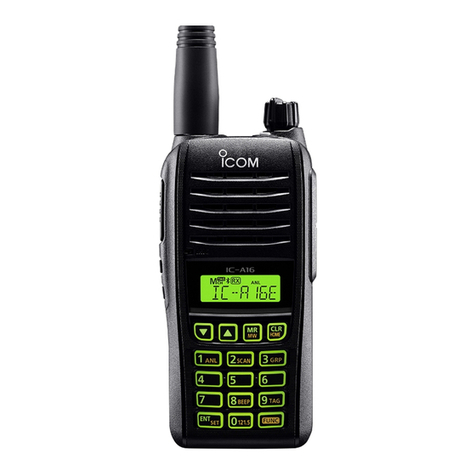
Icom
Icom IC-A16 Installation instructions
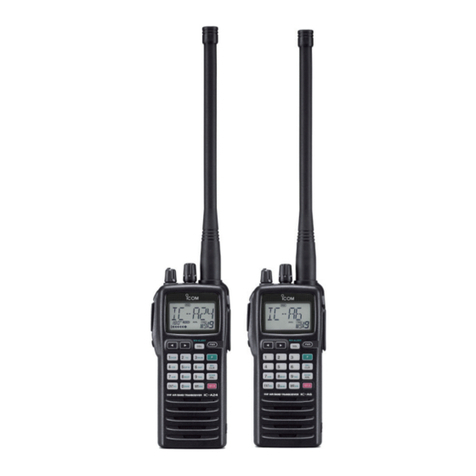
Icom
Icom IC-A24 User manual
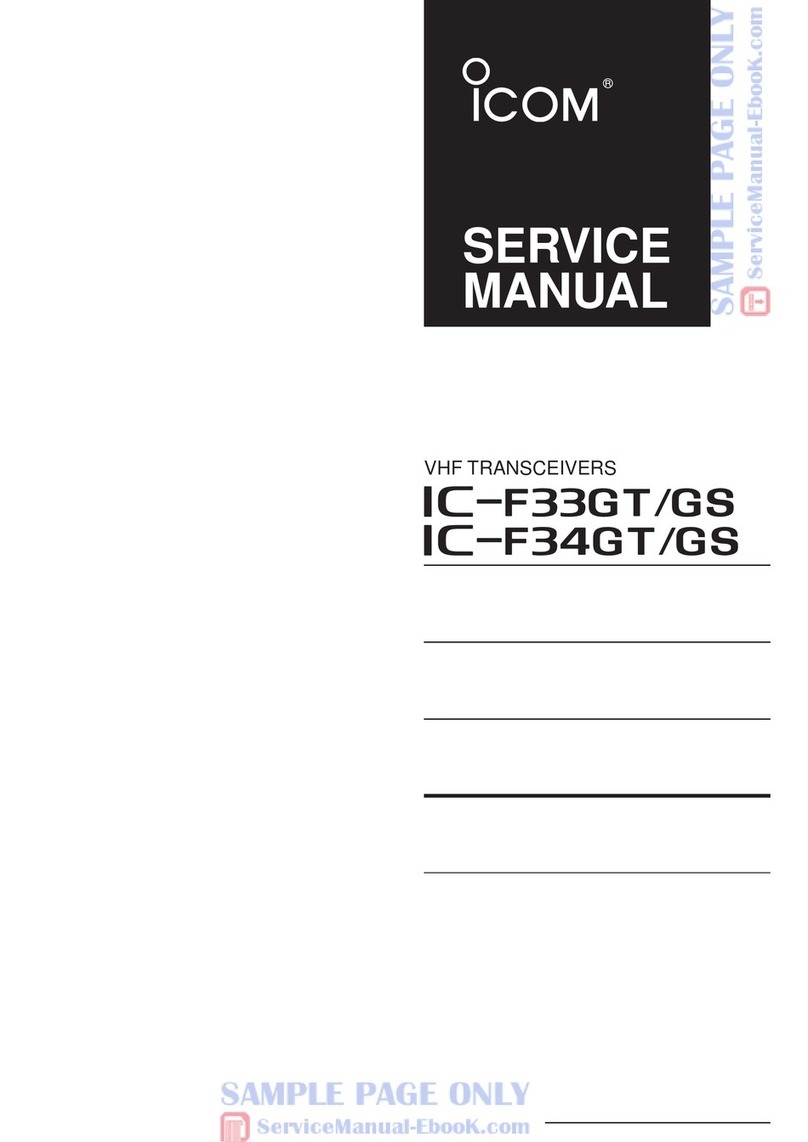
Icom
Icom IC-F33GT User manual
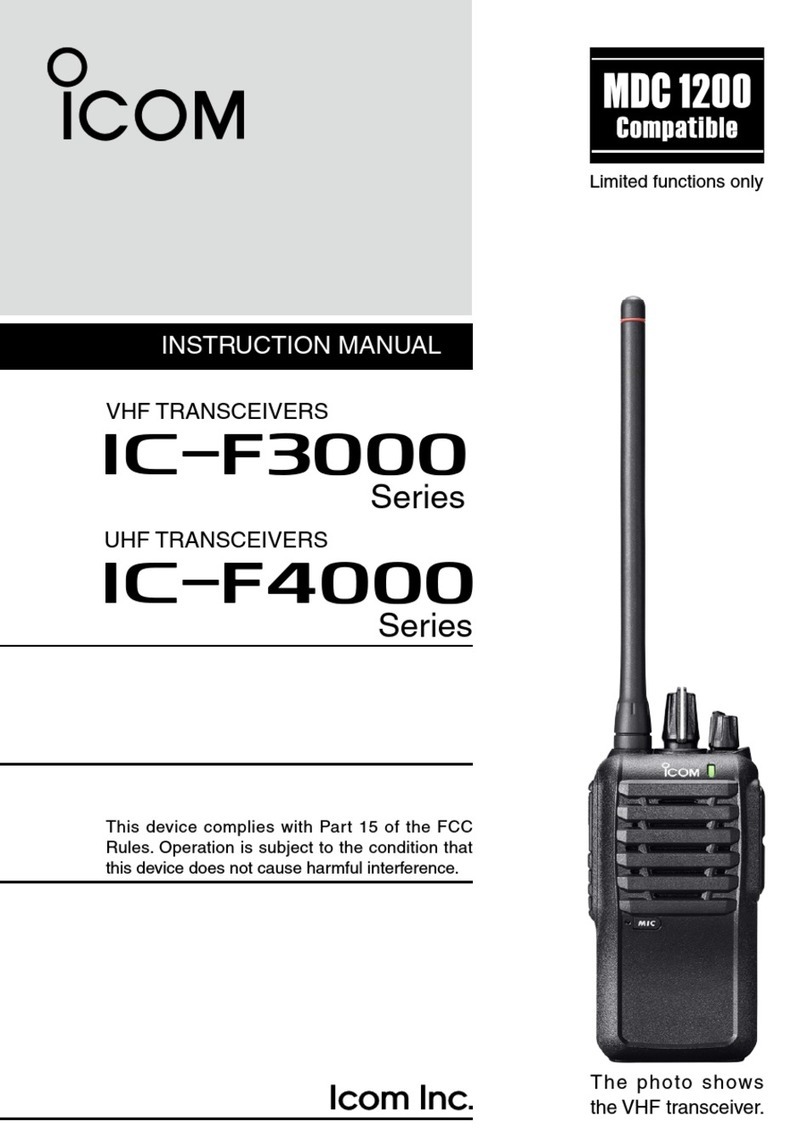
Icom
Icom IC-F3000 Series User manual
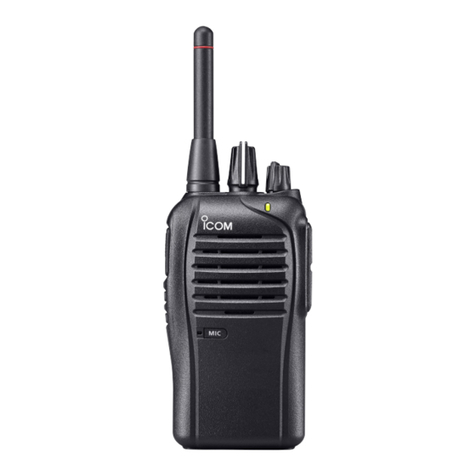
Icom
Icom IC-F27SR User manual

Icom
Icom IC-M423 User manual

Icom
Icom IC-751 User manual
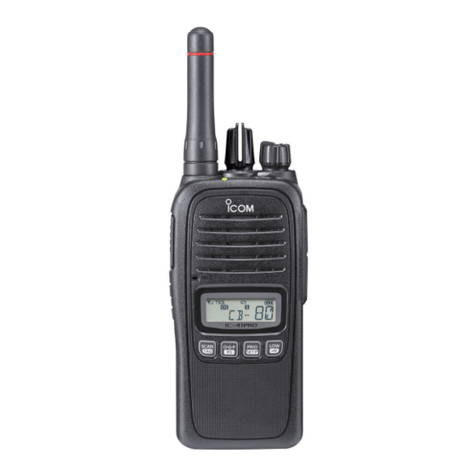
Icom
Icom IC-41PRO Setup guide

Icom
Icom IP730D User manual
Popular Transceiver manuals by other brands
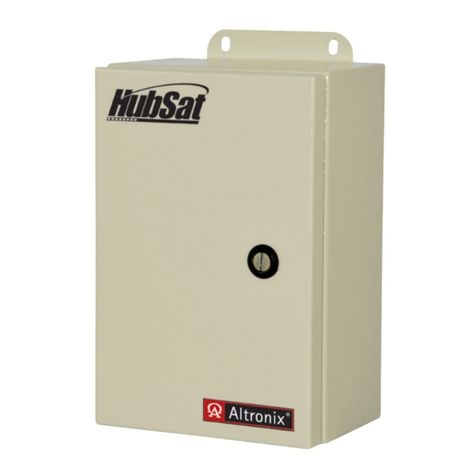
Altronix
Altronix HubSat4WPiV installation guide
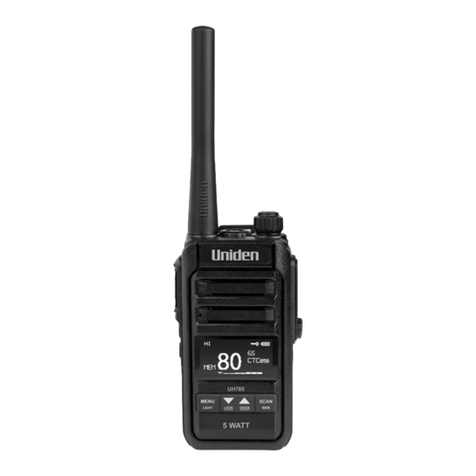
Uniden
Uniden UH785 Series owner's manual
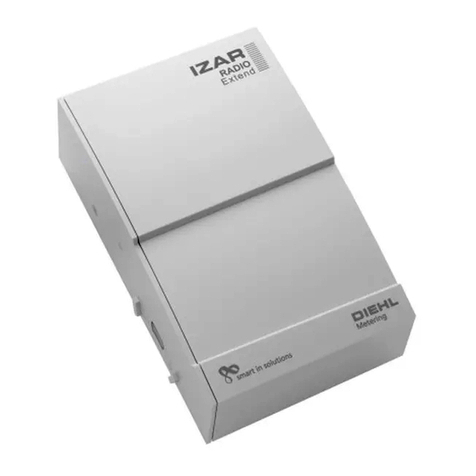
Diehl Metering
Diehl Metering IZAR RADIO Extend installation guide
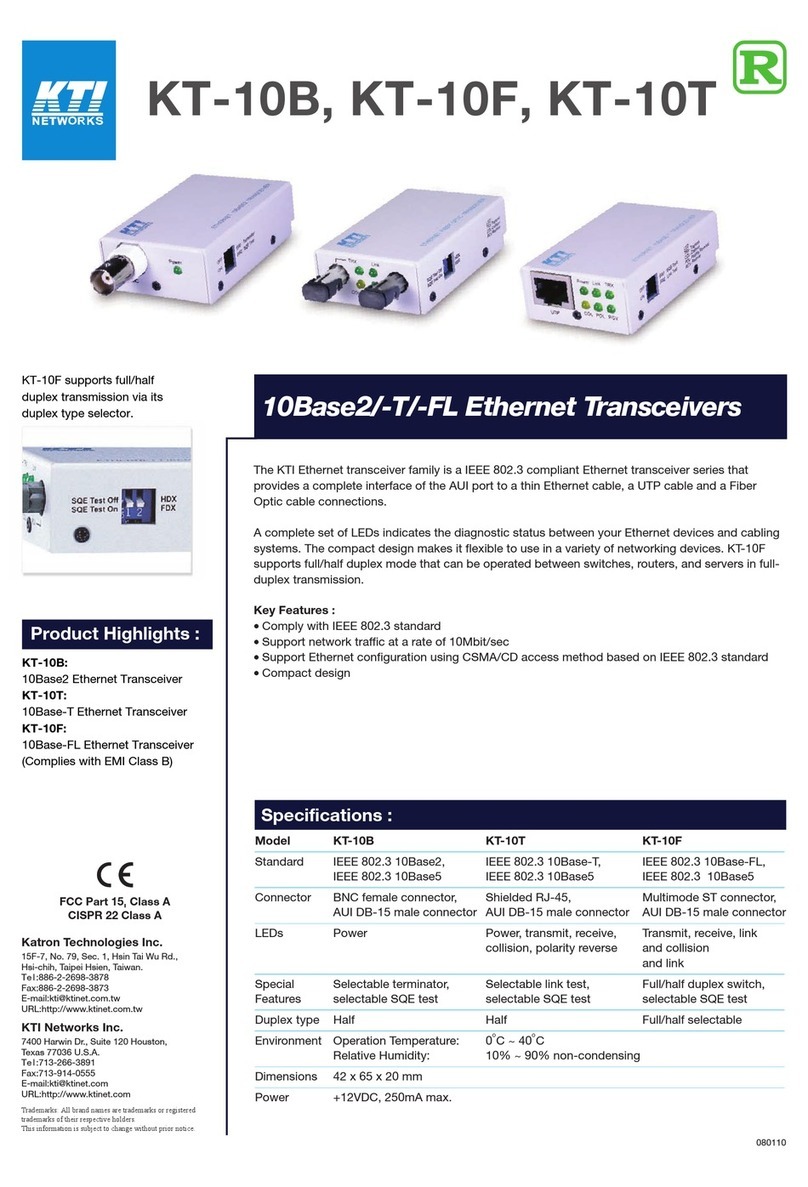
KTI Networks
KTI Networks KT-10B Specification sheet
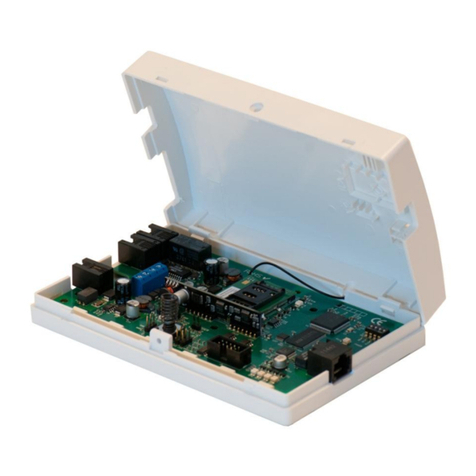
alphatronics
alphatronics PSTN-2-IP GPRS Quick reference guide
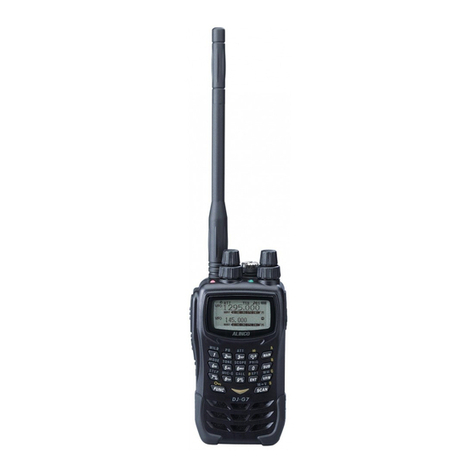
Alinco
Alinco DJ-G7 instruction manual
